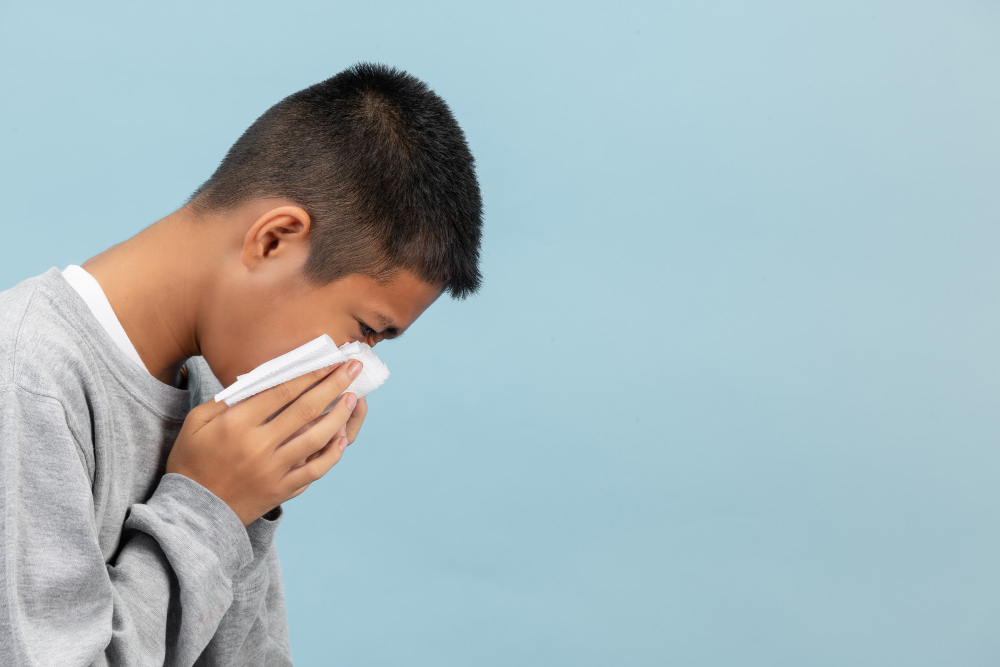Bronchitis is a common illness that affects children. But what is it exactly? It’s when the tubes that carry air to the lungs get sore and swollen. This makes it hard for kids to breathe easily, and they often have a bad cough. Kids can get bronchitis from viruses, bacteria, or even from breathing in smoke or dust.
The Importance of Recognizing Bronchitis Early
Recognizing bronchitis in its early stages is vital for children’s health. Bronchitis in children causes a lot of discomfort and can lead to bigger problems if ignored. Around the world, many kids suffer from this, including a significant number in India. In urban areas, where pollution is high, kids face a greater risk. In India, bronchitis among kids is quite common, with instances increasing during colder months. It’s crucial to know the symptoms. Children are especially vulnerable because their immune systems are still developing. Bronchitis symptoms in children typically start with a cough that gets worse. Kids might feel tired, wheeze, or have a fever. Parents need to be watchful, as young ones can’t always communicate how they feel. Early detection allows for timely treatment, preventing the illness from turning into something more severe. By catching bronchitis early on, parents can ensure that their children receive the best care possible, thus avoiding future complications.
Identifying the Symptoms of Bronchitis in Children
Spotting bronchitis symptoms in children is vital. These symptoms often manifest as a nagging cough. This cough may intensify, becoming more frequent. Wheezing, where the child makes a whistling sound while breathing, can also be a sign. Sometimes, kids might feel extremely tired, as their body is fighting the infection. When bronchitis starts, it is called acute bronchitis. Acute bronchitis in kids is usually temporary and can last a few weeks. However, if untreated, it can lead to chronic issues. Chronic bronchitis in pediatric cases is less common but more serious. Parents should consult a doctor if these symptoms appear. Ignoring or delaying medical advice can worsen a child’s condition. Seeking help early ensures that children get the right tests and treatments. This proactive approach can keep bronchitis from escalating into more serious respiratory problems.
Unpacking the Causes of Bronchitis in Youngsters
There are several bronchitis in children causes. Mostly, it’s due to viral infections. The respiratory syncytial virus is one common virus responsible. Other viruses from the cold or flu can also lead to bronchitis. Sometimes, bacterial infections cause bronchitis. These are less common but can be trickier. The bacteria settle in the lung pathways, causing inflammation. In cities, where pollution levels are high, environmental factors play a role too. Bronchitis in toddlers causes can include exposure to secondhand smoke or harmful fumes. Children living in urban areas in India often breathe polluted air. This can irritate their respiratory tract. Smoke from cigarettes, both direct and secondhand, is another factor. It can seriously impact young lungs, increasing the chance of bronchitis. Parents should be aware of these triggers. Avoiding exposure to harmful substances can significantly reduce the risk for their children.
Comprehensive Treatment for Bronchitis in Children
Treating bronchitis in young ones involves several approaches. Lifestyle changes and bronchitis in infants home remedies can soothe symptoms. For example, keeping kids hydrated helps thin mucus, making it easier to cough up. Humidifiers can also help by moistening the air, reducing coughing. Watching out for signs is essential. If symptoms persist, medical treatment might be required. Doctors might prescribe bronchodilators to help open airways. However, antibiotics are not always necessary unless there’s a bacterial infection. Bronchitis treatment for kids must be decided by a doctor, tailored to each child. Parents should follow the medical advice and not rely solely on home remedies. Regular check-ups ensure the child’s condition improves and does not worsen. The combination of a supportive home environment and medical care can make recovery smoother and prevent future occurrences.
Prevention Strategies to Shield Children from Bronchitis
Preventing bronchitis in young ones is possible with a few simple measures. Encouraging a healthy lifestyle is key. Balanced diets and regular playtime boost a child’s immune system. Keeping the home free of smoke is crucial to prevent bronchitis in children. Cigarettes and other smoke can irritate a child’s lungs, triggering bronchitis. Pollution is another concern, especially in cities. It’s wise to limit outdoor play on high-smog days. Installing air purifiers indoors can also help. These steps reduce exposure to harmful substances. Teaching kids good hygiene, like washing hands frequently, helps too. This way, they avoid spreading germs that can lead to infection. By adopting these strategies, parents can safeguard their children. Promoting these healthy habits offers a simple yet effective barrier against bronchitis and other respiratory issues.
The Long-term Impacts of Neglected Bronchitis
Ignoring bronchitis symptoms can lead to long-term problems. If left untreated, bronchitis can turn into more severe lung issues. Chronic bronchitis pediatric cases might evolve, affecting lung function. This can lead to breathing difficulties that last. Kids suffering long-term might have trouble playing or participating in sports. Regular check-ups with a doctor ensure any ongoing health improvements are tracked. Consistent medical oversight helps catch any progression early. Moreover, neglected bronchitis increases hospital visits. The risk of lung infections also rises. A proactive approach ensures children remain healthy and active. Long-term health is secured by tackling bronchitis in its early stages. This keeps their breathing easy and their playtime joyful.
Conclusion: Promoting Awareness and Proactive Care
Recognizing bronchitis early is essential. Watch for symptoms like coughing and wheezing. Timely medical intervention makes a big difference. Parents can take steps to prevent bronchitis in children by creating safe, smoke-free environments. Play an active role in managing their child’s health by staying informed and proactive about respiratory conditions. Keeping kids healthy today ensures a happier tomorrow.

